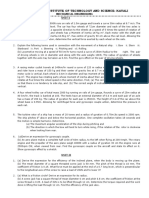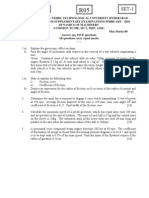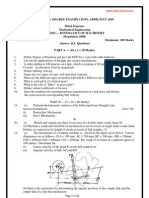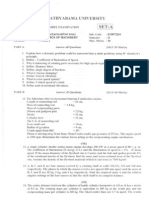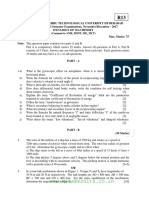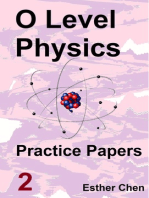Dynamics of Machinery
Dynamics of Machinery
Uploaded by
NORIMAR24Copyright:
Available Formats
Dynamics of Machinery
Dynamics of Machinery
Uploaded by
NORIMAR24Original Description:
Copyright
Available Formats
Share this document
Did you find this document useful?
Is this content inappropriate?
Copyright:
Available Formats
Dynamics of Machinery
Dynamics of Machinery
Uploaded by
NORIMAR24Copyright:
Available Formats
Code No.
V3116/R07
III B.Tech I Semester Regular Examinations November, 2010
DYNAMICS OF MACHINERY
(Mechanical Engineering)
Time: 3 hours Max.Marks:80
Answer any FIVE questions
All questions carry equal marks
*****
1. a) Discuss a naval ship usually subjected to what type of motions and associated gyroscopic effects.
b) An aircraft makes a half circle of 100m radius towards left when flying at 400 km/hr. The engine
and the propeller of the plane weigh 4.9 kN having a radius of gyration of 50 cm. The engine rotates at
3000 rpm clockwise when viewed from the rear. Find the gyroscopic couple and its effect on the aircraft.
[8+8]
2. a) Derive an expression for the efficiency of an inclined plane when a body moves down a plane.
b) A conical pivot supports a load of 20 kN. The angle of cone is 120
0
and intensity of pressure is not to
exceed 0.35 MPa. The external radius is 3 times the internal radius. Find the diameter of the bearings
surface. If =0.065 and rpm of shaft is 120, what power in kW is absorbed by friction?
3. a) Derive a relation for the frictional torque acting on a centrifugal clutch.
b) A band and block brake having 12 blocks, each of which subtends an angle of 16
0
at the centre, is
applied to a rotating drum of 600mm diameter. The blocks are 75 mm thick. The two ends of the band are
attached to pins on opposite sides of the fulcrum at distances of 40 mm and 150 mm. Determine the
maximum braking torque, if a force of 250 N is applied to the lever at a distance of 900 mm from the
fulcrum. Take =0.3. [8+8]
4. a) What is meant by piston effort and crank effort?
b) A machine is coupled to a two stroke engine when produces a torque of (800+180 ) N-m, where
is the crank angle. The mean engine speed is 400 rpm. The flywheel and the other rotating parts
attached to the engine have a mass of 350 kg at a radius of gyration of 220 mm. Calculate (i) the power of
the engine (ii) the total fluctuation of speed of the flywheel when resisting torque is constant and (800+80
) N-m. [4+12]
5. In a spring controlled governor of the Hartung type, the length of the ball and sleeve arms are 80 mm
and 120 mm respectively. The total travel of the sleeve is 25 mm. In the mid position, each spring is
compressed by 50 mm and the radius of rotation of the mass centres is 140 mm. Each ball has a mass of 4
kg and the spring has a stiffness of 10 kN/m of compression. The equivalent mass of the governor gear at
the sleeve is 16 kg. Neglect the moment due to the revolving masses when the arms are inclined,
determine the ratio of the range of speed to the mean speed of the governor. Find also speed in the mid
position. [16]
Set No.1
WWW.WARRIORMAX.COM
WWW.WARRIORMAX.COM
Code No.V3116/R07
6. a) Discuss static and Dynamic balancing.
b) A circular disc mounted on a shaft carries three attached masses 4kg, 3kg and 2.5 kg at radial distances
75 mm, 85mm and 50 mm and at the angular positions of 45
0
, 135
0
, and 240
0
respectively. The angular
positions are measured counter clockwise from the reference line along the x-axis. Determine the amount
of the counter mass at a radial distance of 75mm required for the static balance. [6+10]
7. A four crank engine has the two outer cranks set at 120
0
to each other, and their reciprocating masses
are each 3290 N. The distances between the planes of rotation of adjacent cranks are 45, 75 and 60 cm. If
the engine is to be in complete primary balance, find the reciprocating mass and the relative angular
position for each of the inner cranks. If the length of each crank is 30 cm, the length of each connecting
rod is 120 cm and the speed of rotation is 240 rpm, what is the maximum secondary unbalanced force?
[16]
8. a) Explain the term critical speed, prove that the critical speed of a rotating shaft is the same as the
natural frequency of transverse vibration.
b) A shaft of 8 cm diameter and 80 cm length has one of its ends fixed and the other end carries a disc of
weight 4800 N. The youngs modulus of elasticity for the material of the shaft is 196.2 kN/mm
2
.
Determine the frequency of longitudinal and transverse vibrations. [8+8]
@@@@@
Set No.1
WWW.WARRIORMAX.COM
WWW.WARRIORMAX.COM
Code No.V3116/R07
III B.Tech I Semester Regular Examinations November, 2010
DYNAMICS OF MACHINERY
(Mechanical Engineering)
Time: 3 hours Max.Marks:80
Answer any FIVE questions
All questions carry equal marks
*****
1. a) What do you mean by spin, precession and gyroscopic planes?
b) A turbine rotor of a ship weighs 196 kN and has a radius of gyration of 75 cm. Its speed is 2000 rpm.
The ship pitches 6
0
above and below the mean position. A complete oscillation takes place in 20 seconds
and the motion is simple harmonic. Determine: a) the maximum couple tending to shear the holding down
bolts of the turbine. b) the direction in which the bow will tend to turn while rising, if the rotation of the
rotor is clockwise, when looking from the aft. [6+10]
2. a) Derive the expression for the friction torque of a flat collar bearing by uniform wear theory.
b) The mean diameter of a square threaded screw jack is 50 mm. The pitch of the thread is 10 mm. The
coefficient of friction is 0.15. What force must be applied at the end of a 0.7 m long lever which is
perpendicular to the longitudinal axis of the screw to raise a load of 20 kN and to lower it. [6+10]
3. A simple band brake is fitted on a crane having the diameter of barrel as 50cm. The band embraces 3/4
th
of the circumference of the brake drum of diameter 70 cm. The tight end of the band is attached to the
fulcrum of the brake lever while the slack end of the band is attached to a pin which is 10 cm away from
the fulcrum. Calculate the braking torque acting on the drum shaft if the operating force of 392.4 N is
acting on the lever at a distance of 65 cm from the fulcrum. The coefficient of friction is 0.3. Instead of
attaching the tight end of the band to the fulcrum of the lever, if it is attached to a pin 2 cm away from the
fulcrum of the lever and on opposite side of the pin to which the slack end of the band is attached, what
will be the increase of braking torque acting on the drum shaft? [16]
4. a) Derive a relation for the turning moment at the crankshaft in terms of piston effort and the angle
turned by the crank.
b) A single cylinder, single acting, four stroke gas engine develops 20 kW at 300 rpm. The work done by
the gases during the expansion stroke is three times the work done on the gases during the compression
stroke, the work done during the suction and exhaust strokes being negligible. If the total fluctuation of
speed is not to exceed 2 percent of the mean speed and the turning moment diagram during compression
and expansion is assumed to be triangular in shape, find the moment of inertia of the flywheel. [7+9]
Set No.2
WWW.WARRIORMAX.COM
WWW.WARRIORMAX.COM
Code No.V3116/R07
5. a) Discus the following with respect to governor:
i) Sensitiveness ii) isochronous governors
b) In an engine governor of the porter type, the upper and lower arms are 20 cm and 25 cm long
respectively and pivoted on the axis of rotation. The central load is 147.2 N the weight of each ball is 19.6
N and friction of sleeve together with the resistance of the operating gear is equal to the weight of 24.5 N
at the sleeve. If the limiting inclinations of the upper arms to the vertical are 30
0
and 40
0
, find range of
speeds of the governor. [6+10]
6. Four masses A, B, C and D are completely balanced. Masses C and D make angles of 90
0
and 195
0
respectively with that of mass B in the counter clockwise direction. The rotating masses have following
properties: m
b
=25 kg, m
c
=40 kg, m
d
=35 kg, r
a
=150mm, r
b
=200 mm, r
c
=100 mm, r
d
=180 mm
The Planes B and C are 250 mm apart. Determine i)the mass A and its angular position with that of mass
B ii) the positions of all the planes relative to plane of mass A. [16]
7. a) Derive the condition to the limiting speed for which wheels of the locomotive are not lifted from
rails.
b) A single cylinder oil engine has a stroke of 38 cm and the crank makes 360 rpm. The reciprocating
parts weigh 670 N and revolving parts are equivalent to 800 N at crank radius. A revolving balance weight
is introduced at a radius of 15 cm to balance the whole of the revolving parts and one half of the
reciprocating parts. Find the balancing weight required and the residual unbalanced force on the crank
shaft. [6+10]
8. A steel shaft of 1.5 m long is 95mm in diameter for the first 0.6m of its length, 60 mm in diameter for
the next 0.5 m of the length and 50 mm diameter for the remaining 0.4 m of its length. The shaft carries
two flywheels at two ends, the first having a mass of 900 kg and 0.85 m radius of gyration located at the
95mm diameter end and the second having a mass of 700 kg and 0.55 m radius of gyration located at the
other end. Determine the location of the node and natural frequency of free torsional vibration of the
system. The modulus of rigidity of shaft is assumed as 80 GN/m
2
. [16]
@@@@@
Set No.2
WWW.WARRIORMAX.COM
WWW.WARRIORMAX.COM
Code No.V3116/R07
III B.Tech I Semester Regular Examinations November, 2010
DYNAMICS OF MACHINERY
(Mechanical Engineering)
Time: 3 hours Max.Marks:80
Answer any FIVE questions
All questions carry equal marks
*****
1. A rear engine automobile is travelling along a track of 100 m mean radius. Each of the four road wheels
has a moment of inertia of 2 kg-m
2
and an effective diameter of 60 cm. The rotating parts of the engine
have a moment of inertial of 1 kg-m
2
. The engine axis is parallel to the rear axle and the crank shaft
rotates in the same sense as the road wheels. The gear ratio, engine to back axle, is 3: 1. The vehicle
weighs 14.71 kN and has its centre of gravity 50 cm above the road level. The width of the track of the
vehicle is 1.5 m. Determine the limiting speed of the vehicle around the curve for all the four wheels to
maintain contact with the road surface if this is not cambered. [16]
2. a) Derive the expression for the friction torque of a flat collar bearing by uniform wear theory.
b) In a screw jack, the diameter of the threaded screw is 40 mm and the pitch 8mm. The load is 20 kN and
it does not rotate with the screw but is carried on swivel head having a bearing diameter of 70 mm. The
coefficient of friction between the swivel head and the spindle is 0.08 and between the screw and nut 0.1.
Determine the total torque required to raise the load and the efficiency. [6+10]
3. a) What is meant by self locking and a self energized brake.
b) A centrifugal clutch has 4 shoes which slide radially in a spider keyed to the driving shaft and make
contact with internal cylindrical surface of a rim keyed to the driven shaft. When the clutch is at rest, each
shoe is pulled against a stop by a spring so as to leave a radial clearance of 5 mm between the shoe and the
rim. The pull exerted by the spring is then 500 N. The mass centre of shoe is 160mm from the axis of the
clutch. If the internal diameter of the rim is 400 mm, the mass of each shoe is 8 kg, the stiffness of each
spring is 50 N/mm and the coefficient of friction between the shoe and the rim is 0.3. Find the power
transmitted by the clutch at 500 rpm. [6+10]
4. a) Differentiate between terms crank pin effort and crank effort. Derive an expression for crank pin
effort in terms of piston effort.
b) A punching press is driven by a constant torque electric motor. The press is provided with a fly wheel
that rotates at maximum speed of 225 rpm. The radius of gyration of the flywheel is 0.5m. The press
punches 720 holes per hour; each punching operation takes 2 seconds and requires 15 kN-m of energy.
Find the power of the motor and minimum mass of the flywheel if speed of the same is not to fall below
200 rpm. [7+9]
Set No.3
WWW.WARRIORMAX.COM
WWW.WARRIORMAX.COM
Code No.V3116/R07
5. In a spring loaded governor of the Hartnell type, the mass of each ball is 1 kg, length of vertical arm of
the ball crank lever is 100 mm and that of the horizontal arm is 50 mm. The distance of fulcrum of each
bell crank lever is 80 mm from the axis of rotation of the governor. The extreme radii of rotation of the
balls are 75 mm and 112.5 mm. The maximum equilibrium speed is 5 percent greater than the minimum
equilibrium speed which is 360 rpm. Find, neglecting obliquity of arms, initial compression of the spring
and equilibrium speed corresponding to the radius of rotation of 100 mm. [16]
6. A shaft carries four masses A, B, C and D placed in parallel planes perpendicular to the shaft axis and
in this order along the shaft. The masses of B and C are 353 N and 245 N respectively and both are
assumed to be concentrated at a radius of 15 cm, while the masses in planes A and D are both at a radius
of 20 cm. The angle between the radii of B and C is 100
0
and that between B and A is 190
0
, both angles
being measured in the same sense. The planes containing A and B are 25 cm apart and those containing B
and C are 50 cm apart. If the shaft is to be in complete dynamic balance, determine i) Masses of A and D
ii) distance between the planes containing C and D iii) angular position of the mass D. [16]
7. A two cylinder uncoupled locomotive has inside cylinders 60 cm apart. The radius of each crank is 30
cm. The cranks are at right angles. The weight of the revolving mass per cylinder is 2452.5 N and the
weight of the reciprocating mass per cylinder is 2943 N. The whole of the revolving and 2/3
rd
of the
reciprocating masses are to be balanced and the balanced weights are placed, in the planes of rotation of
the driving wheels, at radius of 80 cm. The driving wheels are 2 m in diameter and 1.5 m apart. If the
speed of the engine is 80 km/hr , find the hammer blow, maximum variation of tractive effort and
maximum swaying couple. [16]
8. a) Derive an expression for the natural frequency of free transverse vibration of simply supported beam
carrying several of point loads by energy method.
b) A shaft 40 mm diameter and 2.5 m long has a mass of 15 kg per metre length. It is simply supported at
the ends and carries three masses 90 kg, 140 kg and 60 kg at 0.8 m, 1.5 m and 2 m respectively from the
left support. Taking E=200 GPa, find the frequency of the transverse vibration. [8+8]
@@@@@
Set No.3
WWW.WARRIORMAX.COM
WWW.WARRIORMAX.COM
Code No.V3116/R07
III B.Tech I Semester Regular Examinations November, 2010
DYNAMICS OF MACHINERY
(Mechanical Engineering)
Time: 3 hours Max.Marks:80
Answer any FIVE questions
All questions carry equal marks
*****
1. a) Discuss Gyroscopic effects on aeroplane.
b) The turbine rotor weighing 9.8 kN rotates at 2000 rpm clockwise when looking from stern. The vessel
pitches with an angular velocity of 0.5 rad/s. Calculate the gyroscopic couple during the rise of bow.
Assume radius of gyration of the rotor as 25.4 cm. [8+8]
2. a) Explain the terms friction circle and friction axis.
b) The shaft of a collar thrust bearing rotates at 200 rpm and carries an end thrust of 10 tonnes. The outer
and inner diameters of the bearing are 480 mm and 280 mm respectively. If the power lost in friction is
not to exceed 8 kW, determine the coefficient of friction of the lubricant of the bearing. [6+10]
3. a) Derive an expression for the frictional torque transmitted by the centrifugal clutch.
b) A single plate clutch both sides effective is required to transmit 27 kW at 1600 rpm. The outer diameter
of the plate is limited to 30 cm, and the intensity of pressure between the plates is not to exceed 6.87
N/cm
2
. Assuming uniform wear and a coefficient of friction of 0.3, find the required inner diameter of the
plates, and the axial force necessary to engage the clutch. [6+10]
4. a) What do you understand by coefficient of fluctuation of speed and coefficient fluctuation of energy?
b) The equation of the turning moment curve of a three crank engine is (9000+1500) N-m, where
is the crank angle in radians. The moment of inertia of the flywheel is 1000 kg-m
2
and the mean speed
is 300 rpm. Calculate i) power of the engine ii) the maximum fluctuation of speed of flywheel in
percentage when the resisting torque is constant and (5000+600) N-m. [4+12]
5. a) Explain the terms sensitiveness, hunting and stability relating to governors?
b) A Proell governor has all the four arms of length 25 cm. The upper and lower ends of the arms are
pivoted on the axis of rotation of the governor. The extension arms of lower links are each 10 cm long and
parallel to the axis when the radius of the ball path is 15 cm. The weight of each ball is 44.15 N and the
central weight of 353.2 N. Determine the equilibrium speed of the governor. [6+10]
Set No.4
WWW.WARRIORMAX.COM
WWW.WARRIORMAX.COM
Code No.V3116/R07
6. A, B, C and D are four masses carried by a rotating shaft at radii 100, 125, 200 and 150 mm
respectively. The planes in which the masses revolve are spaced 600 mm apart and the mass of B, C and D
are 10 kg, 5 kg and 4 kg respectively. Find the required mass A and relative angular settings of the four
masses so that the shaft shall be in complete balance. [16]
7. a) How do you balance reciprocating masses in radial engines?
b) A three cylinder radial engine, driven by a common crank has the cylinders spaced at 120
0
. The
stroke is 125 mm, length of the connecting rod is 225 mm and the weight of the reciprocating mass per
cylinder is 19.6 N. Calculate the primary and secondary forces at crank shaft speed of 1200 rpm. [6+10]
8. A trailer has 1000 kg mass when fully loaded and 250 kg when empty. The spring of the suspension is
350 kN/m. The damping factor is 0.5 when the trailer is fully loaded. The speed is 100 km/hr. The road
varies sinusoidally with a wave length of 5 m. Determine the amplitude ratio of the trailer when fully
loaded and empty. [6+10]
@@@@@
Set No.4
WWW.WARRIORMAX.COM
WWW.WARRIORMAX.COM
You might also like
- ZF Transmission Fault CodesDocument48 pagesZF Transmission Fault CodesAntonio Novo100% (1)
- Phy Chem Experiment 3Document20 pagesPhy Chem Experiment 3eiddnew0% (1)
- Rr320304 Dynamics of MachinesDocument8 pagesRr320304 Dynamics of MachinesSrinivasa Rao GNo ratings yet
- Question Paper Code:: (10×2 20 Marks)Document4 pagesQuestion Paper Code:: (10×2 20 Marks)Iyyappan SubramanianNo ratings yet
- Jntu Question PaperDocument3 pagesJntu Question Paperrohitchanakya76No ratings yet
- Dynamics of MachineryDocument8 pagesDynamics of Machineryrajamutyala4uNo ratings yet
- PBR Visvodaya Institute of Technology and Science: Kavali: Mechanical EngineeringDocument7 pagesPBR Visvodaya Institute of Technology and Science: Kavali: Mechanical Engineeringhod mechNo ratings yet
- 07a60304 - Dynamics of MachineryDocument8 pages07a60304 - Dynamics of MachineryRajaganapathy GanaNo ratings yet
- Au Qp-Me8594 PDFDocument18 pagesAu Qp-Me8594 PDFMariappan VNo ratings yet
- DOM Model QuestionDocument2 pagesDOM Model QuestionSenthilkumar SubbiahNo ratings yet
- NR-310304 - Dynamics of MachineryDocument8 pagesNR-310304 - Dynamics of MachinerySrinivasa Rao GNo ratings yet
- rr320304 Dynamics of MachinesDocument8 pagesrr320304 Dynamics of MachinesSRINIVASA RAO GANTANo ratings yet
- WWW - Manaresults.co - In: (Mechanical Engineering)Document3 pagesWWW - Manaresults.co - In: (Mechanical Engineering)rajuNo ratings yet
- DOM Model PaperDocument2 pagesDOM Model PaperRambabuDaraNo ratings yet
- University QuestionsDocument4 pagesUniversity QuestionsMartin De Boras PragashNo ratings yet
- D04FA48908744891B70ED91613E5E5ABDocument4 pagesD04FA48908744891B70ED91613E5E5AByashvantNo ratings yet
- Mechanics of MachinesDocument4 pagesMechanics of MachinesAshokNo ratings yet
- DOM2Document7 pagesDOM2ds_shivaNo ratings yet
- School of Mechanical and Building Sciences Mee 301 Dynamics of MachineryDocument4 pagesSchool of Mechanical and Building Sciences Mee 301 Dynamics of MachineryNirman ParasharNo ratings yet
- Question Paper Code:: Reg. No.Document3 pagesQuestion Paper Code:: Reg. No.Keesanth Geetha ChandrasekaranNo ratings yet
- Dom Retest 2Document3 pagesDom Retest 2icsea2021No ratings yet
- R05320304-Dynamics of MachineryDocument8 pagesR05320304-Dynamics of MachinerySRINIVASA RAO GANTANo ratings yet
- Model Question BankDocument4 pagesModel Question BankVinod BalakrishnanNo ratings yet
- WWW - Manaresults.Co - In: III B. Tech I Semester Supplementary Examinations, May - 2017 Dynamics of MachineryDocument2 pagesWWW - Manaresults.Co - In: III B. Tech I Semester Supplementary Examinations, May - 2017 Dynamics of MachineryMusalam prabhu tejaNo ratings yet
- Upto 2010 KomDocument36 pagesUpto 2010 KompsnasabariNo ratings yet
- KomDocument11 pagesKompradeepNo ratings yet
- 16ME5DCDOMDocument3 pages16ME5DCDOMyyy 4uNo ratings yet
- Design of Machinery Jntua Previous PapersDocument20 pagesDesign of Machinery Jntua Previous PapersHimadhar SaduNo ratings yet
- Dynamics of Machines QP DOM UPTO 2010Document32 pagesDynamics of Machines QP DOM UPTO 2010Chennai TuitionsNo ratings yet
- DOM Assignment 2022-23Document11 pagesDOM Assignment 2022-23Pratham DakoriaNo ratings yet
- 081B52EFAC704D5AB58072B74C443C48Document3 pages081B52EFAC704D5AB58072B74C443C48yashvantNo ratings yet
- Dynamics of Machinery Question BankDocument8 pagesDynamics of Machinery Question BankArun ShawnNo ratings yet
- Dynamics of MachineryDocument8 pagesDynamics of MachinerysrinivasNo ratings yet
- 161411-161901-Dynamics of MachineryDocument2 pages161411-161901-Dynamics of Machinerywind projectNo ratings yet
- Dynamics of Machinery QuestionsDocument11 pagesDynamics of Machinery Questionslogeshboy0070% (1)
- CAD/CAMDocument2 pagesCAD/CAMNarayanarao PalagaraNo ratings yet
- Tom 7 JuneDocument3 pagesTom 7 JuneAnonymous mXicTi8hBNo ratings yet
- Question Paper Code:: Reg. No.Document3 pagesQuestion Paper Code:: Reg. No.Tejaswi PilakaNo ratings yet
- Me2302: Dynamics of Machinery Question BankDocument14 pagesMe2302: Dynamics of Machinery Question BankNagendar SelvakumarNo ratings yet
- Upto 2010 KomDocument36 pagesUpto 2010 KomRajueswarNo ratings yet
- 2mid Imp Questions ModelsDocument4 pages2mid Imp Questions ModelsSrimanthula SrikanthNo ratings yet
- QB For Mid-IiDocument3 pagesQB For Mid-Iihod mechNo ratings yet
- Dynamics of Machinery Question PapersDocument22 pagesDynamics of Machinery Question PapersMohan Babu S0% (1)
- Dom Re 1Document3 pagesDom Re 1icsea2021No ratings yet
- Our Official Android App - REJINPAUL NETWORK FromDocument3 pagesOur Official Android App - REJINPAUL NETWORK FromAjay KumarNo ratings yet
- Part B & Part C Questions - Unit WiseDocument3 pagesPart B & Part C Questions - Unit WiseShobiNo ratings yet
- 2 - Dynamics of Machinery PDFDocument8 pages2 - Dynamics of Machinery PDFAkhil C KNo ratings yet
- Mom T2 QPDocument1 pageMom T2 QPsutha_me20098282No ratings yet
- 6.assignment QuestionsDocument10 pages6.assignment QuestionsideepujNo ratings yet
- Mechanism MechanicsDocument5 pagesMechanism MechanicsEzmel KazimNo ratings yet
- MEC304 ModelDocument2 pagesMEC304 ModelKKNo ratings yet
- Assignment Questions Dom Me 5004Document5 pagesAssignment Questions Dom Me 5004sharmasweeta927No ratings yet
- Ai 9202Document2 pagesAi 9202Pop EyeNo ratings yet
- S6 QB MeDocument18 pagesS6 QB MevenkiteshksNo ratings yet
- 3 Mech Me8594 Dom QBDocument29 pages3 Mech Me8594 Dom QBSurya SNo ratings yet
- September-2021 (1) WacgDocument2 pagesSeptember-2021 (1) Wacg20-301 AKSHAYNo ratings yet
- WWW - Manaresults.Co - In: (Common To Ame, MSNT, Me, MCT)Document3 pagesWWW - Manaresults.Co - In: (Common To Ame, MSNT, Me, MCT)Sameer MDNo ratings yet
- Dokument - Pub Dom Assignment Flipbook PDFDocument22 pagesDokument - Pub Dom Assignment Flipbook PDFMuhammad SaboorNo ratings yet
- O level Physics Questions And Answer Practice Papers 2From EverandO level Physics Questions And Answer Practice Papers 2Rating: 5 out of 5 stars5/5 (1)
- O level Physics Questions And Answer Practice Papers 3From EverandO level Physics Questions And Answer Practice Papers 3Rating: 3 out of 5 stars3/5 (1)
- Shape Memory Alloy Actuators: Design, Fabrication, and Experimental EvaluationFrom EverandShape Memory Alloy Actuators: Design, Fabrication, and Experimental EvaluationNo ratings yet
- Activity 4 - Projectile and Air Resistance (Activity Guide)Document3 pagesActivity 4 - Projectile and Air Resistance (Activity Guide)Ronel AlbanNo ratings yet
- Physics Lab Worksheet: Experiment 1 Refraction of LightDocument5 pagesPhysics Lab Worksheet: Experiment 1 Refraction of LightAref DahabrahNo ratings yet
- CH 10 - Mechanical SpringsDocument89 pagesCH 10 - Mechanical SpringsAnas TubailNo ratings yet
- Ansi Agma6010 f97 PDFDocument62 pagesAnsi Agma6010 f97 PDFWilliam Noe100% (1)
- 1konsep Dasar TermodinamikaDocument39 pages1konsep Dasar TermodinamikamisrakandiNo ratings yet
- CFD Lecture (Introduction To CFD)Document53 pagesCFD Lecture (Introduction To CFD)mkatweNo ratings yet
- Structural StabilityDocument2 pagesStructural StabilityTibu ChackoNo ratings yet
- Installation Notes RKL Partial Arc ENDocument26 pagesInstallation Notes RKL Partial Arc ENAlex ZXNo ratings yet
- Failure Modes in BeamsDocument5 pagesFailure Modes in BeamsADMIN AAONo ratings yet
- Problem With SolutionDocument3 pagesProblem With SolutionHardiNo ratings yet
- Colloidal Processing of CeramicsDocument18 pagesColloidal Processing of CeramicsmlombardiTO100% (1)
- Thermochemistry:: General ChemistryDocument78 pagesThermochemistry:: General ChemistryDione Gale Naval100% (1)
- Egg Drop Project 01Document7 pagesEgg Drop Project 01Lindita HaskoNo ratings yet
- Basis Set Excel LectureDocument11 pagesBasis Set Excel LectureisohsoNo ratings yet
- Qualitative Theory of Odes An Introduction To Dynamical Systems Theory 1St Edition Henryk Zoladek All ChapterDocument67 pagesQualitative Theory of Odes An Introduction To Dynamical Systems Theory 1St Edition Henryk Zoladek All Chapterdouglas.dixson651100% (8)
- Dtu, Department of Energy Engineering S in (KJ/ (KG K) ) - V in (M 3/Kg) - T in (ºc) M.J. Skovrup & H.J.H Knudsen. 19-11-29 Ref:Peng-Robinson-Stryjek-Vera Equation and Dupont Suva Ac9000Document1 pageDtu, Department of Energy Engineering S in (KJ/ (KG K) ) - V in (M 3/Kg) - T in (ºc) M.J. Skovrup & H.J.H Knudsen. 19-11-29 Ref:Peng-Robinson-Stryjek-Vera Equation and Dupont Suva Ac9000raul correaNo ratings yet
- Perrys TabsDocument4 pagesPerrys TabsJose Daniel AsuncionNo ratings yet
- Top DriveDocument8 pagesTop DriveJayant PrasadNo ratings yet
- Title: Aim:: Terminal VelocityDocument7 pagesTitle: Aim:: Terminal VelocityericaNo ratings yet
- Ray & Wave Optics For JEE Main - Er. D. C. Gupta PDFDocument248 pagesRay & Wave Optics For JEE Main - Er. D. C. Gupta PDFCoc Legend100% (4)
- Phys11 C01 HomeworkDocument4 pagesPhys11 C01 HomeworkAynaticNo ratings yet
- SM Indie08Document11 pagesSM Indie08Christopher TanjungNo ratings yet
- Complete English Grammar RulesDocument4 pagesComplete English Grammar RulesgurueinnelNo ratings yet
- For Peer Review: Investigation of Thermal Stress Distribution in Fiber Reinforced Roller Compacted Concrete PavementsDocument30 pagesFor Peer Review: Investigation of Thermal Stress Distribution in Fiber Reinforced Roller Compacted Concrete PavementspghasaeiNo ratings yet
- Estimating The Low-Speed Sidewash Gradient On A Vertical StabilizerDocument3 pagesEstimating The Low-Speed Sidewash Gradient On A Vertical StabilizerMarco Antonio Zuñiga PerezNo ratings yet
- Solution of Tut 1Document13 pagesSolution of Tut 1Wesley100% (1)
- CE579 Half Course Summary StabilityCourse PDFDocument192 pagesCE579 Half Course Summary StabilityCourse PDFOlivia LeãoNo ratings yet
- Ch-3 Flexural Design of Beams Using WSD MethodDocument12 pagesCh-3 Flexural Design of Beams Using WSD Methodعلي المهندسNo ratings yet






